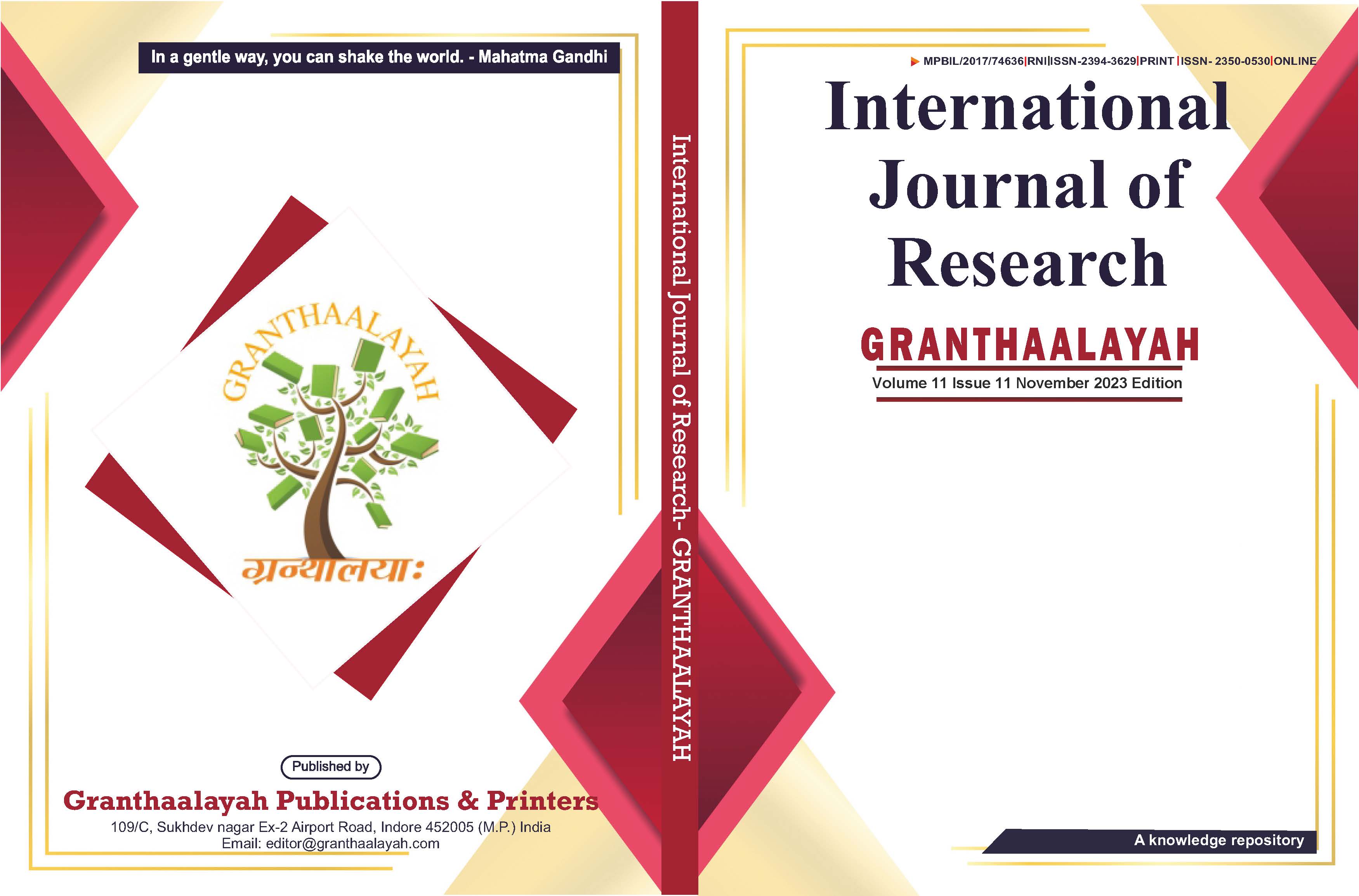ACCESSIBLE WEATHER FORECASTING APP WITH ML AND SPEECH RECOGNITION FOR THE VISUALLY IMPAIRED
DOI:
https://doi.org/10.29121/granthaalayah.v11.i11.2023.6109Keywords:
Weather, Ml, Speech, Agriculture, Transportation, Event Planning, Personal SafetyAbstract [English]
Weather forecasting plays a crucial role in our daily lives, influencing decisions in agriculture, transportation, event planning, and personal safety. This project presents an intelligent weather prediction system powered by advanced machine learning techniques to forecast weather parameters such as temperature, humidity, rainfall, wind speed, and atmospheric pressure. The system collects real-time weather data using an API and leverages historical weather datasets for model training and evaluation.
To achieve high prediction accuracy, this system incorporates robust machine learning algorithms, including XGBoost and Random Forest Regression, known for their effectiveness in handling non-linear relationships and feature interactions. For time-series forecasting tasks, particularly in predicting future rainfall and temperature trends, the project employs Long Short-Term Memory (LSTM) networks due to their capacity to learn temporal dependencies over time.
An innovative feature of this application is its speech recognition interface, enabling voice-based interaction for querying weather reports. This makes the system especially accessible to visually impaired users, allowing them to receive current weather updates hands-free. Additionally, users can access a graphical dashboard that visualizes real-time weather insights and predictions after entering the city name.
Downloads
References
Agrawal, S., & Maji, P. (2020). "Applications of Machine Learning in Weather Forecasting." International Journal of Computer Applications.
Rasel, M., & Hossain, M. A. (2021). "Real-Time Weather Forecasting using Machine Learning." Journal of Intelligent Computing.
Breiman, L. (2001). "Random Forests." Machine Learning, 45(1), 5–32. DOI: https://doi.org/10.1023/A:1010933404324
Chen, T., & Guestrin, C. (2016). "XGBoost: A Scalable Tree Boosting System." Proceedings of the 22nd ACM SIGKDD Conference. DOI: https://doi.org/10.1145/2939672.2939785
Hochreiter, S., & Schmidhuber, J. (1997). "Long Short-Term Memory." Neural Computation, 9(8), 1735–1780. DOI: https://doi.org/10.1162/neco.1997.9.8.1735
OpenWeatherMap API Documentation. https://openweathermap.org/api
Shah, K., & Sharma, M. (2022). "API-Driven Real-Time Weather Prediction System." International Journal of Data Science and Analytics.
Google Speech-to-Text API. https://cloud.google.com/speech-to-text
Cohen, M. (2019). "The Rise of Voice-First Technology in Mobile Applications." VoiceBot.ai.
McKinney, W. (2011). "pandas: a Foundational Python Library for Data Analysis and Statistics." PyCon Proceedings.
Zafar, F., & Hussain, M. (2021). "A Modular Framework for Weather Prediction Using Machine Learning." International Journal of Computer Science.
Khan, I., & Raza, M. (2020). "Efficient Design Patterns for Machine Learning Pipelines in Python." ACM Transactions on Software Engineering.
Chakraborty, S. et al. (2019). "Ensemble Models for Improved Rainfall Forecasting in India." Journal of Hydrology.
Yadav, R., & Tripathi, M. (2020). "Time Series Forecasting of Temperature Using LSTM." Springer Advances in Data Science.
Bigham, J. P., & Ladner, R. E. (2018). "Speech Interfaces for Users with Disabilities." ACM Transactions on Accessible Computing.
Reddy, P., & Kumar, A. (2021). "Designing Inclusive Mobile Applications for Weather Forecasting." Human-Centered Computing Journal.
Pandey, S., & Gautam, A. (2022). "Weather Intelligence for Agricultural Planning." IEEE Access, 10, 56789–56802.
Sharma, R., & Verma, N. (2023). "AI-Powered Solutions for Real-Time Weather Monitoring." AI in Society, 6(2), 123–135.
Kalnay, E. (2003). Atmospheric Modeling, Data Assimilation and Predictability. Cambridge University Press. DOI: https://doi.org/10.1017/CBO9780511802270
Jain, N., & Agrawal, R. (2020). “A Review of Machine Learning Techniques for Weather Prediction.” International Journal of Computer Applications.
Mishra, A., & Ghosh, S. (2018). “Naive Bayes and SVM-based Weather Prediction Models.” International Journal of Computer Science Trends and Technology.
Panahi, F. et al. (2021). “Weather Forecasting using Ensemble Models.” Journal of Applied Meteorology and Climatology.
Dua, D., & Graff, C. (2019). “UCI Machine Learning Repository: Weather Dataset.” University of California, Irvine.
Gupta, S., & Raj, R. (2022). “Comparative Analysis of ML Algorithms in Temperature Forecasting.” Environmental Informatics Archives.
Mahajan, A., & Garg, D. (2020). “Short-Term Rainfall Prediction using KNN.” International Journal of Engineering Research and Technology.
Islam, M. R., & Rahman, M. (2021). “Cyclone Prediction using GRU and Bi-LSTM.” IEEE Access, 9, 123456–123469.
Lakshmanan, V. (2021). “CNN Applications in Satellite-based Weather Modeling.” Remote Sensing Letters.
Lin, S., & Xu, L. (2022). “CNN-LSTM Hybrid for Precipitation Forecasting.” Journal of Hydrology, 600, 126552.
Sharma, R., & Sharma, P. (2021). “API-driven Weather Forecasting Models.” Journal of Data Engineering.
Li, Q., & Zhang, Y. (2020). “Real-Time Learning in Weather Prediction Systems.” IEEE Transactions on Neural Networks.
Singh, A., & Jain, D. (2022). “Voice-Enabled Weather Apps for Smart Cities.” Smart Computing Review.
Reddy, P., & Kumar, A. (2021). “Multilingual Speech Recognition in Rural Weather Forecasting.” Journal of Human-Centered Technology.
McKinney, W. (2011). “Data Analysis with Pandas and Python.” O’Reilly Media.
Dash Python Framework Documentation. https://dash.plotly.com
Kumar, V., & Chauhan, H. (2020). “Visualization-Aided Forecast Systems for Public Use.” International Journal of HCI.
Published
How to Cite
Issue
Section
License
Copyright (c) 2023 Prince, Nikhil Jha, Pushpendra Singh, Amita Kumari

This work is licensed under a Creative Commons Attribution 4.0 International License.
With the licence CC-BY, authors retain the copyright, allowing anyone to download, reuse, re-print, modify, distribute, and/or copy their contribution. The work must be properly attributed to its author.
It is not necessary to ask for further permission from the author or journal board.
This journal provides immediate open access to its content on the principle that making research freely available to the public supports a greater global exchange of knowledge.






























